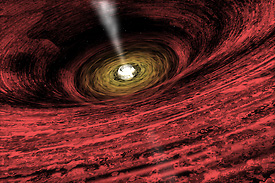Using the deepest X-ray image ever taken, a U-M astronomer and her colleagues have found the first direct evidence that massive black holes were common in the early universe. This discovery from NASA’s Chandra X-ray Observatory shows that very young black holes grew more aggressively than previously thought, in tandem with the growth of their host galaxies.
By pointing Chandra at a patch of sky for more than six weeks, astronomers obtained what is known as the Chandra Deep Field South (CDFS). When combined with very deep optical and infrared images from NASA’s Hubble Space Telescope, the new Chandra data allowed astronomers to search for black holes in 200 distant galaxies, from when the universe was between about 800 million and 950 million years old.

An artist’s impression of a growing supermassive black hole located in the early universe shows a disk of gas rotating around the central object that generates copious amounts of radiation. This gas is destined to be consumed by the black hole. Image by CNASA, CSC, A. Hobart.
“We had reason to expect that black holes existed in many of the very first galaxies, but they had evaded our searches until now. When I compared Chandra’s data to my theoretical models I was stunned by their agreement. It’s the dream of any theoretician,” says Marta Volonteri, associate professor of astronomy and co-author of the study that appears in last week’s Nature.
The super-sized growth means that the black holes in the CDFS are related to quasars, very luminous, rare objects powered by material falling onto supermassive black holes. However, the sources in the CDFS are about a hundred times fainter, and the black holes are about a thousand times less massive than the ones in quasars.
It was found that between 30 percent and 100 percent of the distant galaxies contain growing supermassive black holes. Extrapolating these results from the small observed field to the full sky, there are at least 30 million supermassive black holes in the early universe. This is a factor of 10,000 larger than the estimated number of quasars in the early universe.
“It appears we’ve found a whole new population of baby black holes,” says co-author Kevin Schawinski of Yale University. “We think these babies will grow by a factor of about a hundred or a thousand, eventually becoming like the giant black holes we see today almost 13 billion years later.”
A population of baby black holes in the early universe had been predicted, but not yet observed. Detailed calculations show that the total amount of black hole growth observed by this team is about a hundred times higher than recent estimates.
“Until now, we had no idea what the black holes in these early galaxies were doing — or if they even existed,” says Ezequiel Treister of the University of Hawaii, lead author of the study. “Now we know they are there and they are growing like gangbusters.”
Because these baby black holes are nearly all enshrouded in thick clouds of gas and dust, optical telescopes frequently cannot detect them. However, the high energies of X-ray light can penetrate these veils, allowing the black holes inside to be studied.
Two critical issues in black hole physics are how the first supermassive black holes were formed and how they grow. Although evidence for parallel growth of black holes and galaxies has been established at closer distances, the new Chandra results show that this connection starts earlier than previously thought, perhaps right from the origin of both.

